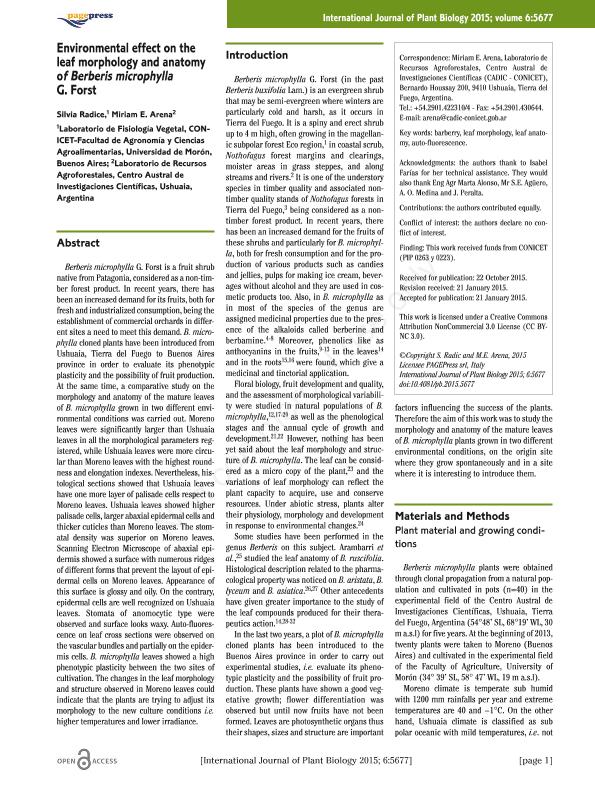Mostrar el registro sencillo del ítem
dc.contributor.author
Radice, Silvia

dc.contributor.author
Arena, Miriam Elisabet

dc.date.available
2016-12-02T17:24:46Z
dc.date.issued
2015-06
dc.identifier.citation
Radice, Silvia; Arena, Miriam Elisabet; Environmental effect on the leaf morphology and anatomy of Berberis microphylla G. Forst; PAGEPress; International Journal of Plant Biology; 6; 5677; 6-2015; 1-7
dc.identifier.uri
http://hdl.handle.net/11336/8675
dc.description.abstract
Berberis microphylla G. Forst is a fruit shrub native from Patagonia, considered as a non-timber forest product. In recent years, there has been an increased demand for its fruits, both for fresh and industrialized consumption, being the establishment of commercial orchards in different sites a need to meet this demand. B. microphylla cloned plants have been introduced from Ushuaia, Tierra del Fuego to Buenos Aires province in order to evaluate its phenotypic plasticity and the possibility of fruit production. At the same time, a comparative study on the morphology and anatomy of the mature leaves of B. microphylla grown in two different environmental conditions was carried out. Moreno leaves were significantly larger than Ushuaia leaves in all the morphological parameters registered, while Ushuaia leaves were more circular than Moreno leaves with the highest roundness and elongation indexes. Nevertheless, histological sections showed that Ushuaia leaves have one more layer of palisade cells respect to Moreno leaves. Ushuaia leaves showed higher palisade cells, larger abaxial epidermal cells and thicker cuticles than Moreno leaves. The stomatal density was superior on Moreno leaves. SEM of abaxial epidermis showed a surface with numerous ridges of different forms that prevent the layout of epidermal cells on Moreno leaves. Appearance of this surface is glossy and oily. On the contrary, epidermal cells are well recognized on Ushuaia leaves. Stomata of anomocytic type were observed and surface looks waxy. Auto-fluorescence on leaf cross sections were observed on the vascular bundles and partially on the epidermis cells. B. microphylla leaves showed a high phenotypic plasticity between the two sites of cultivation. The changes in the leaf morphology and structure observed in Moreno leaves could indicate that the plants are trying to adjust its morphology to the new culture conditions i.e. higher temperatures and lower irradiance.
dc.format
application/pdf
dc.language.iso
eng
dc.publisher
PAGEPress
dc.rights
info:eu-repo/semantics/openAccess
dc.rights.uri
https://creativecommons.org/licenses/by-nc-sa/2.5/ar/
dc.subject
Barberry
dc.subject
Leaf Morphology
dc.subject
Leaf Anatomy
dc.subject
Auto-Fluorescence
dc.subject.classification
Horticultura, Viticultura

dc.subject.classification
Agricultura, Silvicultura y Pesca

dc.subject.classification
CIENCIAS AGRÍCOLAS

dc.title
Environmental effect on the leaf morphology and anatomy of Berberis microphylla G. Forst
dc.type
info:eu-repo/semantics/article
dc.type
info:ar-repo/semantics/artículo
dc.type
info:eu-repo/semantics/publishedVersion
dc.date.updated
2016-12-01T19:54:55Z
dc.identifier.eissn
2037-0164
dc.journal.volume
6
dc.journal.number
5677
dc.journal.pagination
1-7
dc.journal.pais
Italia

dc.journal.ciudad
Pavia
dc.description.fil
Fil: Radice, Silvia. Consejo Nacional de Investigaciones Científicas y Técnicas; Argentina. Universidad de Moron; Argentina
dc.description.fil
Fil: Arena, Miriam Elisabet. Consejo Nacional de Investigaciones Científicas y Técnicas. Centro Austral de Investigaciones Científicas; Argentina
dc.journal.title
International Journal of Plant Biology
dc.relation.alternativeid
info:eu-repo/semantics/altIdentifier/url/http://www.pagepress.org/journals/index.php/pb/issue/archive
dc.relation.alternativeid
info:eu-repo/semantics/altIdentifier/doi/http://dx.doi.org/10.4081/pb.2015.5677
Archivos asociados
